Hearing aids come in many styles and sizes. For years, behind-the-ear (BTE) hearing aids have been the most commonly used devices, but in-canal devices are growing in popularity. (1) These invisible hearing aids sit in your ear, making them discreet. They are ideal for people who want to hide their hearing aids due to perceived stigma. (2, 3)
For our Sony hearing aid review, we evaluated three completely-in-canal (CIC) hearing aids: the Sony CRE-C20, the Sony CRE-C10, and the Sony CRE-E10. We compared each device’s features, pricing, and effectiveness in treating mild to moderate hearing loss in adults. We also asked our team of experts to weigh on what you should know before choosing the best hearing aid for you.
Our favorite Sony hearing aid
Backed by Sony audio technology and WS Audiology expertise, the CRE-C20 is our favorite Sony hearing aid. This affordable, over-the-counter, discreet device offers impressive sound quality, and the settings can be tailored to your hearing needs. These CIC hearing aids are earbud-style and have a rechargeable battery.
Our picks for the best Sony hearing aids
Compare Sony hearing aids
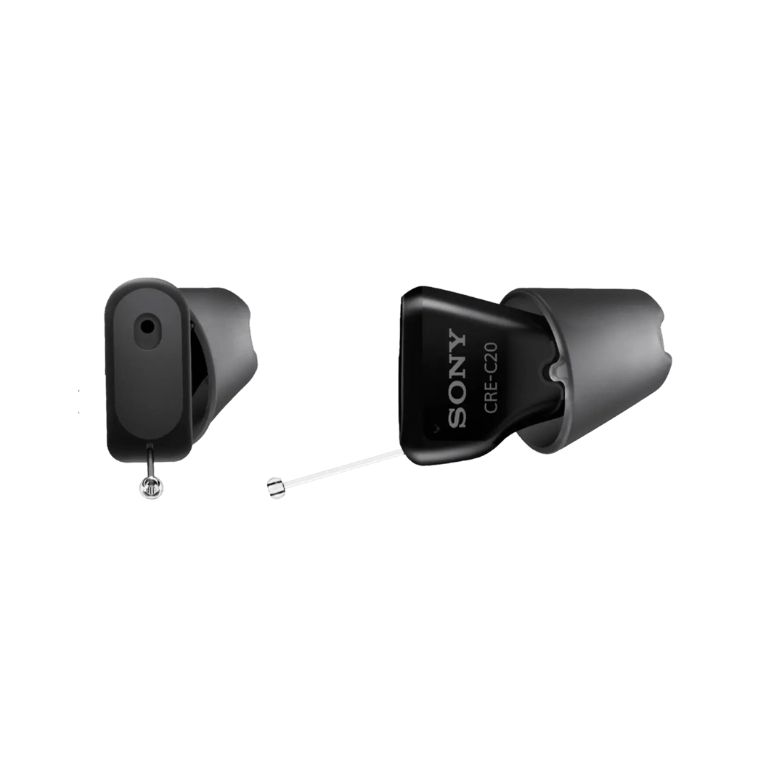
|
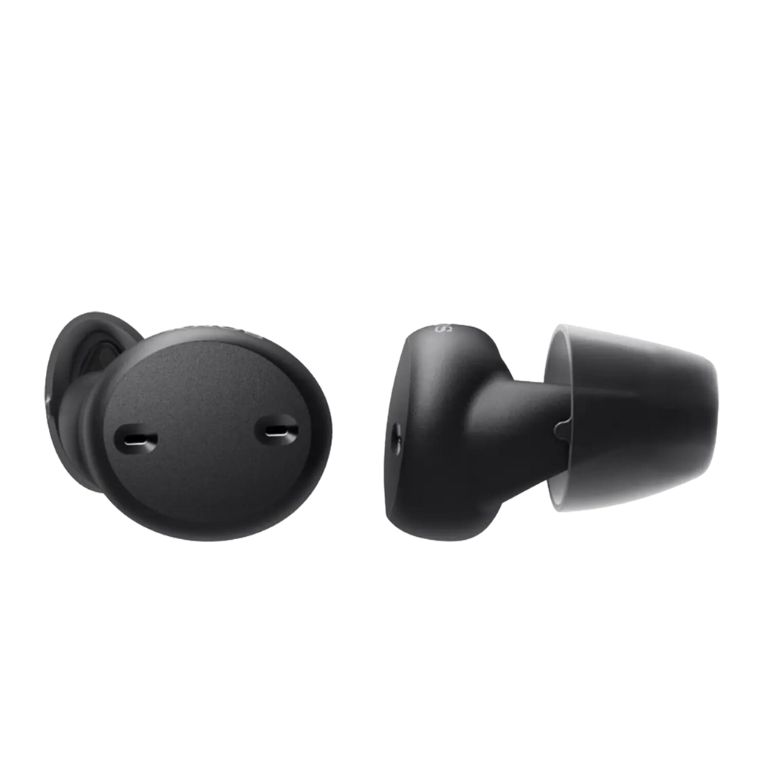
|
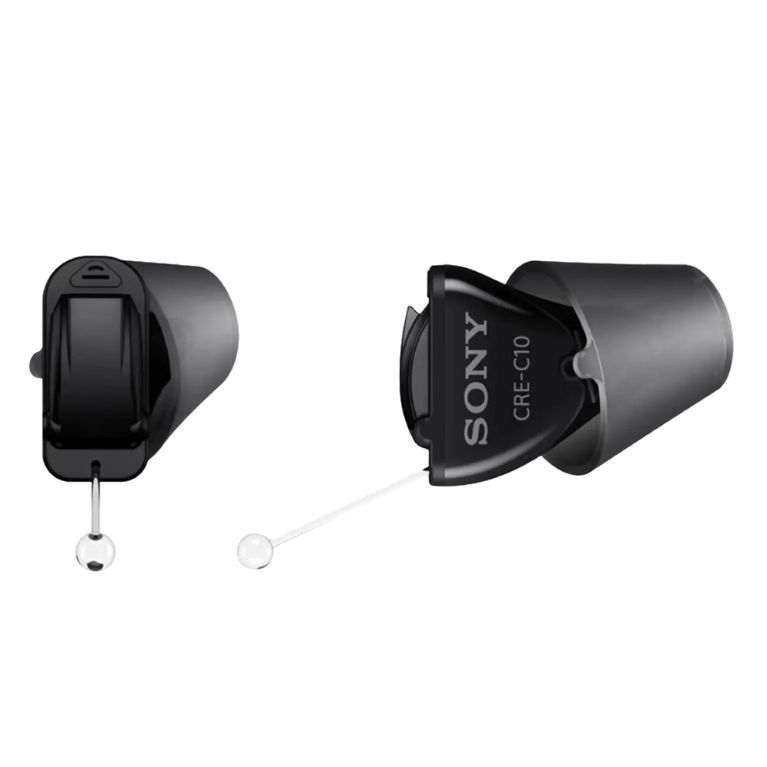
|
|
| Sony CRE-C20 | Sony CRE-E10 | Sony CRE-C10 | |
| Rating | |||
| Price | $999.99 | $1,099.99 | $799.99 |
| Style | Completely-in-canal (CIC) | CIC | CIC |
| Battery | Rechargeable | Rechargeable | Replaceable |
| Bluetooth | No | Yes | No |
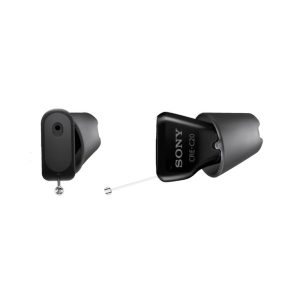

Key product features
What you should know
The Sony CRE-C20 is the updated model of the Sony CRE-C10. These rechargeable hearing aids come from a trusted source (Sony and WS Audiology) and offer impressive sound technology for their size. Better yet, their long list of benefits is bundled into a small, discreet package.
- Sony’s sound technology is the standout feature. It enhances sound by automatically reducing noise and focusing its microphone to improve understanding in crowded environments.
- The C20 costs $999.99, which is mid-range compared to other OTC hearing aids.
- The rechargeable C20 has one of the longest wear times in the industry, making it convenient for all-day use and active wearers.
- The advanced fitting process is done completely in the app, so you can tailor the hearing aid to your listening needs.
- New, enhanced ear sleeves make the CRE-C20 incredibly discreet, and it fits comfortably inside the ear canal.
Sony CRE-C20 hearing aids overview
The technology used in the Sony CRE-C20 is from the same manufacturer that creates Signia hearing aids, which retail for more than four times the price. This gives users access to quality hearing solutions typically found in prescription devices for a much lower price.
Specs
| Style | CIC |
| Battery | Rechargeable |
| Bluetooth | Yes |
| Prescription | No, OTC |
| Warranty | 12 months |
| Financing | Yes |
| Dimensions | N/A |
Features and technology
The CRE-C20 are Sony’s newest OTC hearing aids. Sony says they offer improved sound quality by prioritizing speech clarity according to your surroundings, helping you focus conversations better.
What’s most impressive, the Sony Hearing Control app includes a “fine tuning” setting where you can describe a problem you’re having by selecting from a dropdown menu, and Sony will offer a solution you can test. For example, the app can recommend an adjusted setting if you tell it that you can hear your own voice or you find others’ speech too quiet. This is a feature we haven’t yet seen from other brands, and it enables users to address common hearing aid problems on their own without visiting a doctor’s office.
Plus, the CRE-C20 boasts the longest all-day wear time of most OTC hearing aids we’ve tested, up to 28 hours, with a case that provides two additional charges. It’s hard to find a battery lifespan longer than this unless you purchase a prescription device like the Starkey hearing aids, which last up to 51 hours.
Price and value
At $999, the Sony CRE-C20 offers many of the benefits of prescription hearing aids for much less money. However, its price is somewhat high for an OTC hearing aid that doesn’t have Bluetooth. Another OTC device, the Lexie B2 Plus Powered by Bose, is priced at $999 and has Bluetooth. However, we think Sony’s impressive sound quality and ease of use help justify its price point.
Getting a hearing test and counseling from a trained hearing professional in a clinic can be helpful in pinpointing the specifics of your hearing loss and the hearing aid features that could help you treat it, but that often comes with a significant price increase. (4) Sony’s self-fitting hearing test is quite effective at building a hearing profile that suits your individual preferences.
Related post: How do hearing aids work?
Programming and adjustments
Pairing your device to the Sony Hearing Control app takes about 20 minutes. If you need help, Sony’s website has several instructional videos that walk you through pairing and setting up your hearing aids.
The device’s built-in hearing test uses beeps in various frequencies to fine-tune your sound profile. Testers say this process is quick, seamless, and effective. Some apps can be overly designed, confusing users. We think Sony’s app is basic yet informative enough to help people use their hearing aids daily.
You’ll use the app’s treble and bass slide feature to adjust the volume and sound balance. The app also allows you to adjust loudness or sharpness, troubleshoot issues, and change your settings.
While we commend Sony for making adjustments easy, the C20 lacks directional microphones and preset hearing modes found in other OTC hearing aids. Directional microphones help amplify sounds of interest in relation to the background noise level (known as the signal-to-noise ratio). (5) Sony’s E10 hearing aid has directional microphones and costs just under $1,100.
What customers are saying
The Sony CRE-C2O earns 4.2 out of five stars from an average of more than 40 reviews on Amazon. Happy customers say the hearing aids are easy to set up, reliable, and have natural sound quality.
“Going through setup is a breeze. Just like in a doctor’s office but using your smartphone, you download the app and listen to tones and report how many of them you hear 0, 1, 2, or 3, and setting up both hearing aids independently takes about twenty minutes. Then you can hear again! Bass is there, mids too. I have no idea how something so small can last for a day without recharging, but Sony somehow managed to figure it out. No tinniness, no robotic squawk, you can lay with your ear on a pillow or listen to on-ear headphones, and there’s no feedback squeal,” says verified customer Mark D. on Amazon.
A few customers compared the Sony CRE-C2O to Eargo hearing aids, which are almost triple the price. “The Sony CRE-C20 is much more natural-sounding compared to Eargo 7. There are almost no feedback noises compared to Eargo, and I’m hearing sounds that I forgot existed,” says Amazon verified customer Hassan.
Multiple reviews mention difficulty charging their device. “I have a very hard time getting the aids to register that they are charging. I put the aid on the cradle, it looks to me like the contacts connect, but the charge light doesn’t come on. I juggle the aid a little, and it comes on. Or not. Or comes on and then turns off a few seconds later. While the aids work, the nightly anxiety about whether they’re charging correctly is frustrating,” says Amazon verified customer Lawson S.
Some customers say it took them several weeks to get the Sony hearing aids fitted or tuned properly, but once they did, they were happy with their purchase. CIC hearing aids can be tough to fit because the only customizable feature is the ear molds in your canal. The CRE-C20 comes with four sizes of ear sleeves. Experiment with each size to find the best fit. It may take up to 30 days for your brain to adjust to hearing aids, so we recommend wearing them daily for at least a month to determine their effectiveness. (6)
Who the Sony CRE-C20 hearing aid is recommended for:
- Wearers who can comfortably use a smartphone: The Sony CRE-C20 is great for users who like maintaining control of their devices using an app.
- Active adults who want to wear their devices all day: Wearers can choose from several sizes of ear sleeves that comfortably fit their ear shape and canal. This fit and its extra-long battery life make it ideal for all-day use.
- People who prefer a discreet device: The C20 is a CIC, earbud-style aid that is nearly invisible in most ear canals.
Who the Sony CRE-C20 hearing aid is not recommended for:
- Anyone prioritizing Bluetooth: The Sony C20 does not allow phone calls or music streaming.
- Adults with dexterity issues: CIC-style hearing aids are small, which limits their ability to be adjusted with a switch or by tapping on the device. Wearers who struggle with inserting and removing small devices may want to consider a larger, behind-the-ear style model.
- People with severe hearing loss or hearing-related injuries: Experts advise, and Sony agrees, that OTC hearing aids aren’t a good option for people with severe hearing loss, one-sided hearing loss, ear injuries, dizziness or vertigo, fluctuating hearing loss, ringing or buzzing in one ear, or blood, pus, or fluid coming from the ear in the past six months. (7)
How we rated the Sony C20
We gave SONY MODEL hearing aids a 4.6 out of 5 rating based on the following categories:
- Performance: Sound quality, noise reduction, feedback control, programmability, and connectivity
- Features: Durability, battery options, hearing loss range, wireless connectivity, water resistance, and safety features
- Value: Insurance coverage and financing options
- Customer experience: Shipping, warranty, and customer support
Review our full hearing aids testing methodology to learn about our rating process.
Warranties and policies
All Sony hearing aids come with a one-year limited warranty that covers the hardware components delivered to you in the original package. Sony’s warranty does not cover accessories. To extend the warranty on hearing aids, wearers can purchase additional protections, including:
- Protect plan ($119.99): Two-year coverage plan that extends the manufacturer’s limited warranty and includes additional benefits such as priority service and a free replacement.
- Protect Plus plan ($149.99): Three-year extended coverage with additional protection for accidental damage.
Sony will honor its 45-day return policy if you can provide proof of purchase.
Additional models from Sony
Sony currently offers three hearing aid models: the C20, the older C10, and the E10 Bluetooth hearing aids. All devices are compatible with the Sony Hearing Control app.


Key product features
What you should know
- Automatically analyzes, adjusts, and optimizes sound based on your surroundings, including noise reduction.
- Testers say these Bluetooth hearing aids are simple to set up and use. However, streaming is only possible with iOS devices.
- Costs under $1,100.
Recommended for:
- Bluetooth lovers who want to be able to stream music and phone calls through their hearing aid.
- People who work or are often in noisy environments like restaurants or public spaces and could benefit from directional microphones.
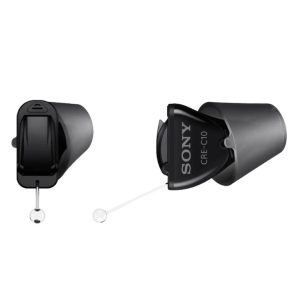

Key product features
What you should know
- At $799, the CRE-C10 is Sony’s most affordable hearing aid.
- They have many of the same features as the CRE-C20, like self-fitting capabilities, one microphone, and noise management, but the C10 uses replaceable batteries.
- Testers say these hearing aids are very comfortable and stay in place but be warned that they sit far in the ear canal, which may take some getting used to.
Recommended for:
- Budget shoppers or those new to hearing aids.
- People who want a discreet device but do not need streaming capabilities.
Sony C20 vs. competitors

|
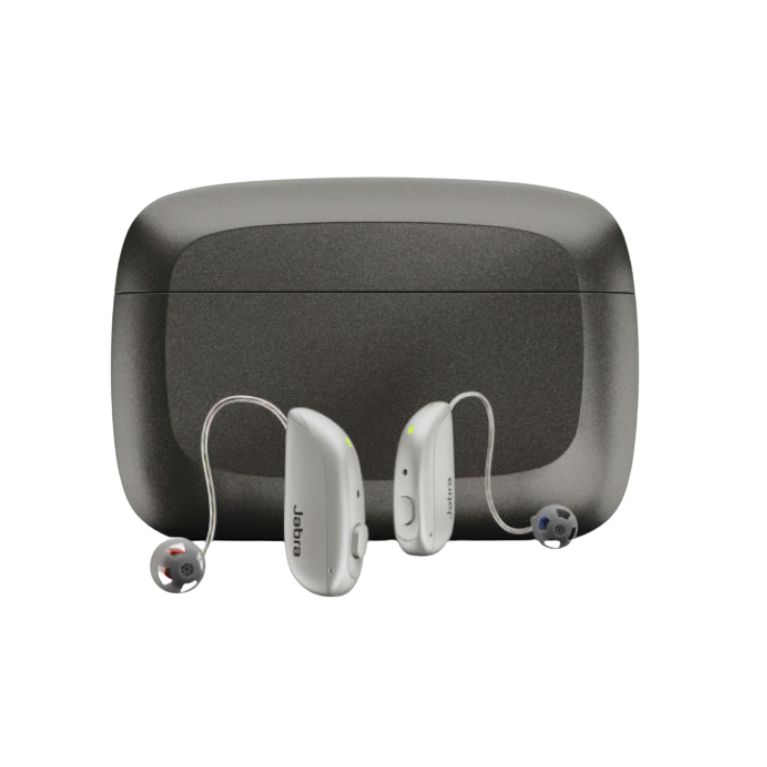
|
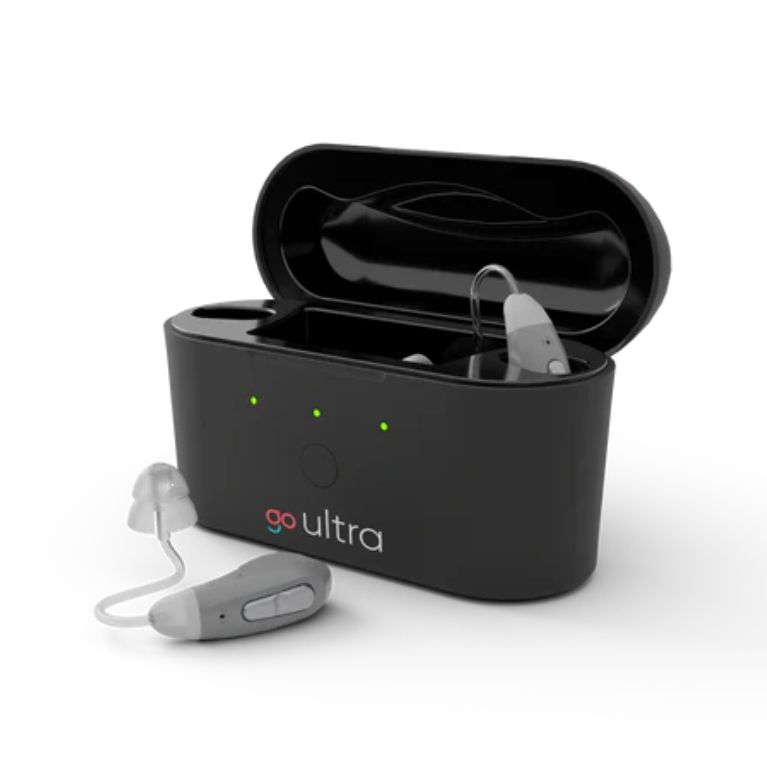
|
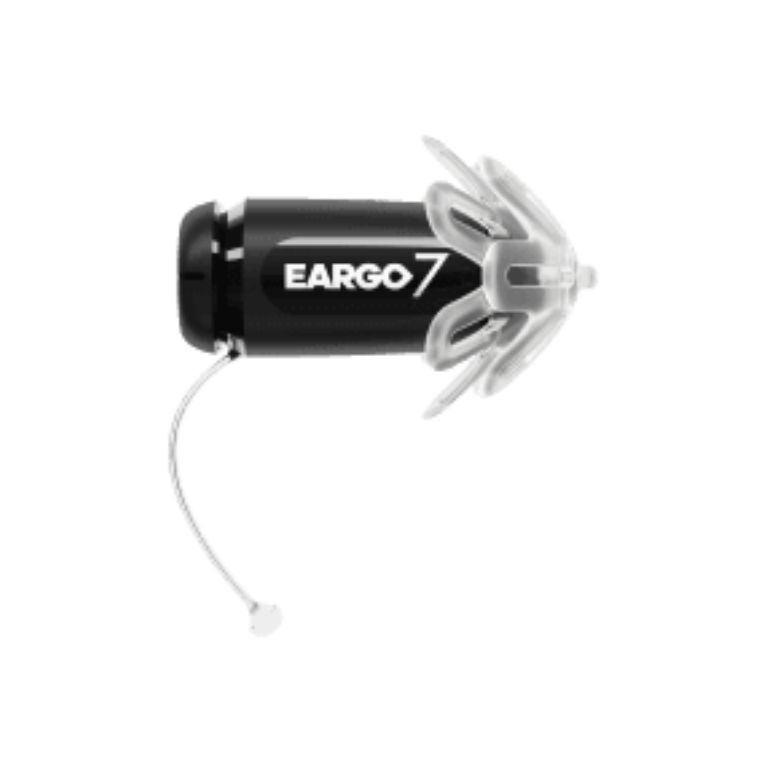
|
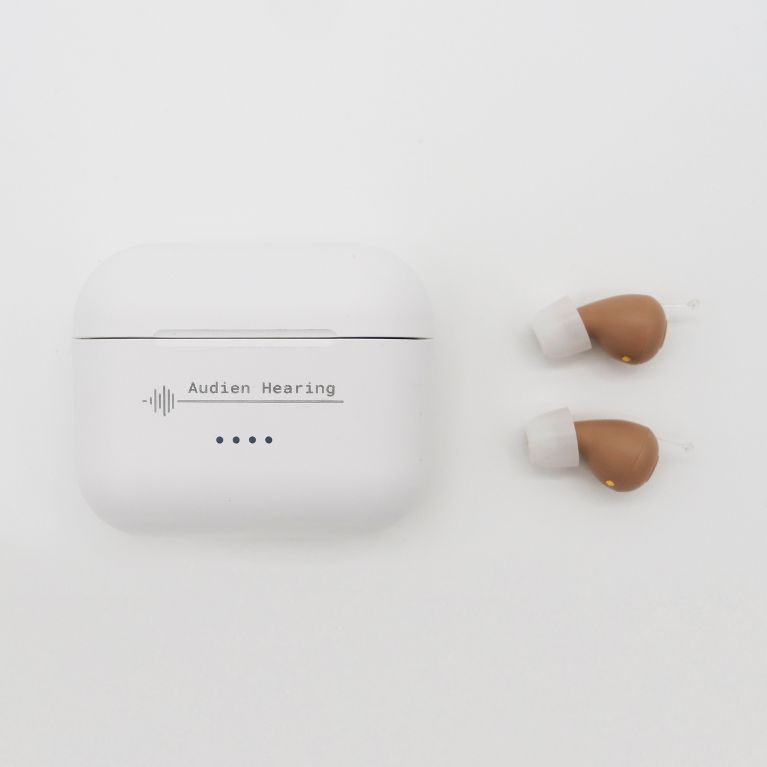
|
|
| Sony C20 | Jabra Enhance Select 500 | Go Hearing Go Ultra | Eargo 7 | Audien Atom Pro 2 | |
| Rating | |||||
| Price | $999.99 | $1,795–$1,995 | $499 | $2,950 | $289 |
| Style | CIC | BTE | OTC | CIC | ITE |
| Battery | Rechargeable | Rechargeable | Rechargeable | Rechargeable | Rechargeable |
| Bluetooth | No | Yes | Yes | No | No |
The Sony C20 is a budget-friendly, discreet hearing aid suitable for those with mild to moderate hearing loss who are comfortable using a smartphone to adjust the settings. When comparing Sony against competitors, consider your budget and the features that are important to your lifestyle. Sony C20 has an industry-leading battery life that outshines other OTC hearing aids. However, it lacks Bluetooth streaming capabilities, and its small style may be hard for people with limited dexterity to handle.
The Eargo 7 is the closest comparable model to the Sony C20 in style and features, but it costs almost triple. The reason? The Eargo 7 uses AI technology to improve sounds in different listening environments.
If you want to stream calls and music to your device, check out Jabra hearing aids. Like the Sony CRE-C20, the Jabra Enhance Select 500 is an OTC, rechargeable device that’s Bluetooth enabled. However, the Select 500 does not sit completely in the ear canal, so they are not as discreet as the Sony hearing aids.
A feature not often discussed as a differentiator among brands and devices is the hearing aid’s water resistance rating. Sony C20 carries an IP68 rating, deeming it resistant to dust, water, and moisture. (8) The Eargo 7 is not dust-resistant (rated IPX7), and Go Hearing devices and Audien hearing aids aren’t labeled as water- or dust-resistant.
Sony hearing aid prices
Sony hearing aids cost between $799.99 and $1,099.99, depending on the model. The E10 is the brand’s most expensive model because it includes Bluetooth capabilities, a rechargeable battery, and advanced sound customizations in the app via directional microphones. The C20 is an improved version of the C10 and falls in the middle of the price range at $999.99. The C10 is the most affordable hearing aid from Sony, priced at $799.99.
Sony CRE-C10 vs. Eargo 7
The Sony CRE-C10 is most commonly compared to the Eargo 7. Both OTC devices are practically invisible in the ear, but the CRE-C10 uses a disposable battery you must replace every five to seven days. The Eargo 7 has a rechargeable battery that lasts up to 16 hours.
Both devices let you adjust volume through their proprietary apps and offer advanced sound technology to reduce background noise, enhance conversations, and adjust to your environment. Where Eargo outshines Sony is its AI-powered sound adjustments, but you’ll pay almost three times more. Our testers say the Eargo 7 setup and programming is more advanced than the self-fitting options offered by Sony.
How to choose the best hearing aid for you
When shopping for hearing aids, consider factors like your type and degree of hearing loss, the cost of the device, its technology and features, and your personal preferences. We recommend starting with a hearing test to learn about your type of hearing loss. From there, you can prioritize features that suit your treatment needs and lifestyle.
Hearing aids vary in cost and technology, and what’s right for you may not suit another. Consult an audiologist or hearing health professional to determine the best hearing aids for your needs. They’ll recommend styles and models with the technology you need to treat your type of loss. For example, some of the smallest devices are almost invisible but can be tough to put in your ears or change the batteries.
FAQs
Does Sony make good hearing aids?
Sony is a top headphone manufacturer. It leverages its trusted brand reputation and audio experience to develop three OTC hearing aids that help clarify sounds and conversations.
Who makes Sony hearing aids?
Sony’s OTC hearing aids are designed in partnership with WS Audiology, a leading hearing aid manufacturer that owns brands like Widex and Signia.
Are Sony hearing aids FDA-approved?
Sony self-fitting hearing aids are FDA-cleared as OTC devices intended to amplify sound for individuals 18 years of age or older with perceived mild to moderate hearing impairment. This allows the agency to monitor the brands involved in producing and distributing regulated products according to the guidelines set in the 2022 OTC ruling. (9, 10) While FDA involvement can signal to customers that a brand is taking the development and distribution of its products seriously, FDA-registered and FDA-cleared are not the same thing. Not all hearing aid companies are FDA-approved or cleared.
Our experts
Dr. Soma Mandal
Dr. Mandal is a board-certified internist and is considered one of the top physicians in midlife women’s health. She has helped thousands of women navigate aging and reinvent themselves. Her mission is to empower women with the latest knowledge, tools, and resources to make the forties and fifties plus, fabulous.
She has been selected by her peers to Castle Connolly Top Docs, New York Top Doctors, Inside Jersey Top Doctors, and Millburn-Short Hills Super Doctors.
Dr. Mandal completed an internship and residency at NYU Langone Medical Center and a prestigious research fellowship in evidence-based medicine at the University of Oxford, England. She practices at a thriving practice in Summit Health, New Jersey.
Krista Manning
Krista Manning is an accomplished medical copy editor and fact-checker who stands out in the pharmaceutical, health, and wellness domains. With a meticulous eye for detail and a command of medical language, Krista ensures the accuracy and clarity of content. Beyond her professional expertise, Krista is an advocate for mental health awareness. Recognizing the crucial intersection of psychological and physical well-being, she actively contributes to projects that promote mental health awareness within the healthcare narrative. Krista’s commitment extends beyond the pages she edits, emphasizing the holistic nature of health communication.

Lauren Hamer
Fortune Recommends Writer
About Author
References
- Grand View Research. Hearing Aids Market Size & Trends Analysis Report. Accessed October 30, 2024.
- The Hearing Review. Survey Details OTC Self-Fitting Hearing Aid Users’ Experiences, Perceptions. Accessed October 30, 2024.
- Wallhagen MI. The stigma of hearing loss. The Gerontologist. 2010; 50(1), 66–75. https://pmc.ncbi.nlm.nih.gov/articles/PMC2904535/
- Cleveland Clinic. Hearing Test (Audiometry). Accessed October 30, 2024.
- Ricketts T A. Directional hearing AIDS. Trends in amplification. 2001; 5(4), 139–176. https://pmc.ncbi.nlm.nih.gov/articles/PMC4168924/
- John Hopkins Medicine. Frequently Asked Questions About Hearing Aids. Accessed October 30, 2024.
- National Institute on Deafness and Other Communication Disorders. Over-the-Counter Hearing Aids. Accessed October 30, 2024.
- Oukitel. IP68 vs. IPX7: How to Choose the Best Water Resistance for Your Gear? Accessed October 30, 2024.
- U.S. Food and Drug Administration. Are There “FDA Registered” or “FDA Certified” Medical Devices? How Do I Know What Is FDA Approved?. Accessed October 30, 2024.
- U.S. Food and Drug Administration. Regulatory Requirements for Hearing Aid Devices and Personal Sound Amplification Products. Accessed October 30, 2024.
